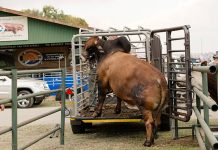Solar panels require a capital outlay over four times higher than the Winglette wind turbines and have a total energy cost 14 times higher. Robyn Joubert spoke to engineer Hans van Eden, who developed them with scientists from the universities of Stellenbosch and Potchefstroom.
Winglette wind turbines have evolved over 25 years to become one of the most advanced wind generators in their class. Just like windmills of days gone by, Winglettes are built to last and work independently and reliably. The turbines were designed by Harrismith engineer Hans van Eden and scientists from Potchefstroom and Stellenbosch universities.
Effective design
The Winglette is a horizontal-axis machine consisting of a three-blade rotor, a generator, a main frame and a tail. It captures the kinetic energy of wind and converts it into electricity. The Winglette is mounted on top of a high tower. A power-supply cable runs down the centre of the tower and connects the wind generator via a controller to a battery bank.
The power in the battery bank can be inverted to 110V or 240V AC, at 50Hz or 60Hz, as required by the system in use. The power stored in this battery bank can then be directed via an inverter to the facility needing electricity. Three aerodynamic blades are designed to extract the maximum amount of energy from wind. Their diameter from tip to tip is 3,6m, while the swept area is 10,2m² for the 3kW unit.
The blades can operate safely in wind speeds of up to 200km/hour and the tail safely steers the head out of high-wind speeds to protect the machine from rotating too fast, and from storm-wind damage.
The Winglette blades are manufactured from fibreglass with a highly polished UV-stabilised finish. Their uniquely designed airfoils produces energy at optimum efficiency at low to medium wind speeds. Hans says the blades show a much wider range of efficiency than most existing competitors due to a wide, low-drag bucket. “The blades also prove to be more efficient when they get dirty, and produce more power than most other designs,” he says.
The rotor is fitted with a parabolic fibreglass nosecap mounted onto the Winglette’s permanent magnet alternator. The alternator can operate at 36V, 48V, 120V or 240V, and produce maximum power at about 450rpm.
Stand tall
The machine can be fitted onto any suitable stand-alone or guy-wired tower. “Tower height is critical as the wind generator must have a clear shot at the wind to perform well,” explains Hans. “The cheapest way to increase the power of your Winglette is to increase its tower height, as wind velocity increases radically with height. One 3kW Winglette wind generator on a 30m tower produces more than twice as much energy as two 3kW Winglettes on 12m towers.”
Wind speed is also affected by landscape variation such as surface roughness, trees and buildings. Hans’s rule of thumb for tower height is to choose a tower size at least 6m higher than twice the height of the obstacles within 150m of the wind generator. In open grassland, the turbulence obstacle height should be taken as 6m.
Prior to installing a wind turbine, Hans recommends doing a “wind resource assessment” at the proposed site to see if the wind will generate sufficient power.
“If you want to install a machine on your farm in an area where the average wind speed is between 5m/second and 6m/ second, the expected power production of your 3kW Winglette mounted on an 18m tower will be about 15kW-hours per day,” he explains.
Multiple applications
The Winglette wind generator, properly installed on a sufficiently high tower, will produce enough electricity to serve household power needs such as a deep freeze, fridge, microwave oven, kettle, washing machine, radio, TV and computers.Heating elements, such as those in a stove, can be powered by gas, and geysers can be powered by solar panels. For operations requiring more power, for example a dairy, a 3kW or 5kW Winglette should generate enough electricity, although smaller machines can also be coupled together if power consumption increases.
The 3kW unit is a popular choice for normal household use. For holiday homes a 1,5kW unit will do, and if one needs power for a school, clinic or holiday resort, one or more of the 5kW or even 10kW machines might be a suitable installation.








